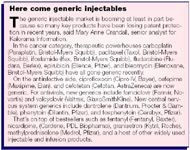Why generic injectables are taking center stage
Generic injectable products are coming into the market. This article details the flood of new entrants.

If you saw that message on e-mail, you'd delete it as spam. But this spam is for real.
Margins on generic injectable products can be two to three times higher than margins on oral formulations, said Timothy van Biesen, healthcare practice partner at Bain & Co. in New York. The biggest reason: there are fewer competitors in generic injectables than in generic oral products. Fewer competitors means higher prices, higher margins, and higher profits.
But higher margins are only one reason the generic injectables market is booming. There are also more potential products as more and more injection and infusion products typically used in hospital settings lose patent protection.
There has been a flood of chemotherapeutics, antiinfectives, antivirals, central nervous system and other products for injection or infusion coming off patent in the last three to five years, explained Mary Anne Crandall, senior analyst for market research firm Kalorama Information (see sidebar).
"Drugmakers are also gearing up for the generic biologics market," Crandall said. "That prospect has made them all take a second look at the injectables market."
Barr acquired significant injectables expertise when it bought Croatian drugmaker Pliva in 2006. Hospira, already a leading injectables supplier in the United States, went global when it bought Australia-based Mayne Pharmaceuticals in 2007.
Other players are also launching injectable lines, said Robert Felicelli, Hospira's VP and general manager, specialty pharmaceuticals, The Americas.
"We are seeing an expansion in the number of competitors in the injectable market," Felicelli said. "There are far more players now than there were even three years ago, even with the mergers and acquisitions that have taken place."
One reason for the flood of new entrants is economic. Felicelli is anticipating high single-digit growth in generic injectables over the next 10 years. There will be hills and valleys as patent expirations rise and fall from year to year, but the overall growth trend is up.
That is in contrast to the oral side of the generic market, where van Biesen sees growth hitting a wall by 2012. Almost every blockbuster statin, blood pressure, and gastrointestinal oral product will lose patent protection within four years.
"It's going to be tough going (for generic makers) once all these big products are off patent," he said. "That's one reason injectables and biogenerics are so important. The industry needs that continuing product growth."
Thinking differently
About 95% of the hospital drug spend goes to injectables and other non-oral formulations, said Ross Day, R.Ph., senior product manager for Novation. The group purchasing organization (GPO) handles drug purchasing for about 30% of U.S. hospitals, he said.

That is no different from the oral solid market, which has seen spectacular growth in recent years as blockbuster after blockbuster loses patent protection. But that is as far as the similarities between the oral and injectable markets go.
FDA’s Recent Exemptions: What Do They Mean as We Finalize DSCSA Implementation?
October 31st 2024Kala Shankle, Vice President of Regulatory Affairs with the Healthcare Distribution Alliance, and Ilisa Bernstein, President of Bernstein Rx Solutions, LLC, discussed recent developments regarding the Drug Supply Chain Security Act.